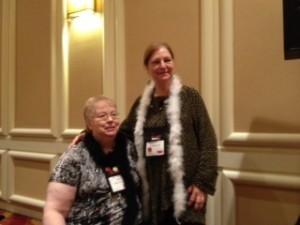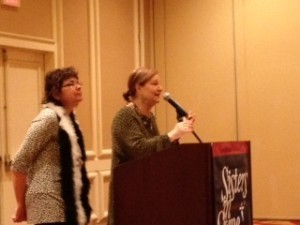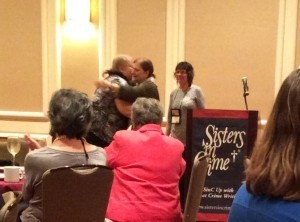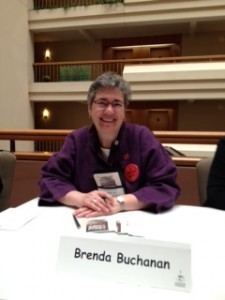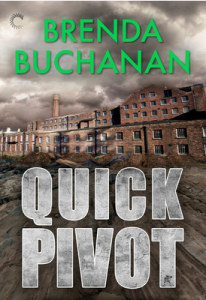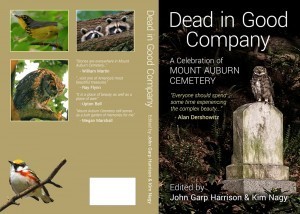Lea Wait's Blog, page 292
May 7, 2015
Master of All Masters.
 Vaughn Hardacker here: Recently, I was talking to a young couple, parents of two children, four and six, and the topic of how we entertain our kids came up. As I expected several techniques were mentioned, all of which were technology-based. I thought back to my childhood and wondered how we survived in the days before personal computers, DVDs, CDs, the internet, cable TV, and of course video games. The answer of course, BOOKS!
Vaughn Hardacker here: Recently, I was talking to a young couple, parents of two children, four and six, and the topic of how we entertain our kids came up. As I expected several techniques were mentioned, all of which were technology-based. I thought back to my childhood and wondered how we survived in the days before personal computers, DVDs, CDs, the internet, cable TV, and of course video games. The answer of course, BOOKS!
I learned to read, and thus started a life-long love affair with books, reading fairy tales to my younger brother (four years my junior). As children we listened to them and laughed or cringed with fear (keep in mind this was before Disney stole the genre and romanticized all of the stories) never realizing that each of them had a point to make. Hans Christian Anderson’s immortal The Little Mermaid was written as a warning to his society that what we do does have consequences.
One of my favorites was a short little story entitled Master of All Masters. The story illustrates the problems that can occur when people who use different words to describe things. It is short so I will include it here. The version below is the English one, although similar tales exist in multiple cultures such as Scotland and in India. For those who would rather let someone else do the reading you can see a famous version of the story told by Danny Kaye at https://vimeo.com/59088091.
Master of All Masters: An English Fairy Tale
A long time ago in England, there was a very poor family: a mother, a father and a daughter named Jane. They were so poor that they didn’t have enough to eat. So one night, the mother didn’t eat supper, and the next night the father didn’t eat supper. And when Jane was fully-grown, she too took a turn and didn’t eat supper every third night.
After several months, Jane thought, “I think my parents can manage this farm on their own. If I got a job on another farm, I could eat there. Then we all would have enough to eat. That’s what I need to do – find a job on another farm.”
So Jane told her parents of her plan.
“But Jane,” cried her mother, “We would miss you so!”
“And it’s so close to Christmas, too!” said her father sadly.
“I will miss you too,” replied Jane, “I know – I will only take a job if I can spend every Sunday and every holiday with you.”
So Jane’s parents reluctantly agreed. That very afternoon, after Jane had finished her chores, she packed a tiny bundle of her extra clothes, and started walking to the village.
On the way, she met a man, also walking to the village.
“Well, young lady,” he said heartily and haughtily, “Why are you walking to the village this afternoon?”
“I’m looking for a job on a farm.”
“Really? Is that true? What a coincidence! I am going to the village to hire someone to work on my farm. I just decided this very morning that I had enough money to do that.” He looked at her very carefully, from the top of her head all the way down to her toes. “Just what sort of work can you do on a farm?”
“Why sir, I’ve been doing all sorts of work on my parents’ farm my whole life. I can plant and harvest the crops, I’m very good with the animals, and I can cook and take care of the house.”
“Well, well, well,” he said. “You’re just the sort of worker I’m looking for.”
So they started discussing how much he would pay her.
“Sir, I will only be working for you 6 days a week. I must go home and spend each Sunday with my parents.”
“That’s fine, Jane,” he replied, “As long as you make me a good hot meal on Saturday night, leave me enough prepared food for Sunday, and are back in time to serve me a hot breakfast on Monday morning.”
“Very good, sir. Why don’t we try this for a week to see if we’re both happy with this arrangement?”
“That’s a good idea, Jane, a very good idea.”
So they turned around and started walking back to his farm. He was thinking,
“Isn’t that just like me? I decide to hire someone in the morning and even before I get to the village, I’ve hired someone that very afternoon! Hmm, isn’t that just like me?” And he let out a great sigh of contentment.
Then he turned to Jane. “What will you call me, Jane?”
“Why, sir, or master, or whatever you wish.”
“Jane, I want you to call me Master of all Masters.”
“Alright, Master of all Masters, whatever you wish.”
When they got to his farm, he said, “It’s getting late, Jane. I’ll show you around the outside of this prosperous farm tomorrow morning. Right now, let’s go inside.”
So he led her to the kitchen. “Over there, in the corner, is where you’ll be sleeping, Jane.
What do you call what you’ll be sleeping on?”
“Why, a bed or a couch, or whatever you wish, Master of all Masters.”
“Jane, I want you to call that,” he said thoughtfully, “A barnacle.”
“A barnacle,” Jane repeated, rather doubtfully. “Whatever you wish, Master of all Masters.”
“What do you call what I’m wearing on my legs?”
“Why, trousers or pants, or whatever you wish, Master of all Masters.”
“Jane, I want you to call them,” he said thoughtfully, “Squibs and crackers.”
“Squibs and crackers,” Jane repeated, again rather doubtfully. “Whatever you wish, Master of all Masters.”
But she was thinking, “I think he’s a little crackers!”
Just then a cat dashed across the kitchen floor.
“What do you call that, Jane?”
“Why, a cat or a kitten, or whatever you wish, Master of all Masters.”
“Jane, I want you to call that,” he said thoughtfully, “White-faced simony.”
“White-faced simony,” Jane repeated carefully. “Whatever you wish, Master of all Masters.”
Pointing to something in another corner, he asked, “What do you call that, Jane?”
“Why, that’s a Christmas tree, Master of all Masters.”
“Jane, I want you to call that,” he said thoughtfully, “A Druid’s arbor.”
“A Druid’s arbor,” Jane repeated slowly. “Whatever you wish, Master of all Masters.”
“And what is next to the, ah, Druid’s arbor, Jane?”
“Why, the fire or flame, or whatever you wish, Master of all Masters.”
“Jane, I want you to call that,” he said thoughtfully, “Hot cockalorum.”
“Hot cockalorum,” Jane repeated very slowly. “Whatever you wish, Master of all Masters.”
Jane was getting very tired, trying to remember all these silly words, and keep straight which was what…
“What is in this bucket, Jane?”
“Why, I call that water but I imagine that you call it something else, Master of all Masters.”
“Yes, I do. Jane, I want you to call that,” he said thoughtfully, “Pondalorum.”
“Pondalorum,” Jane repeated with a sigh. “Whatever you wish, Master of all Masters.”
“What do you call everything you see, Jane?”
“Why, I call that your farm but you call it ?”
“I call it,” he said thoughtfully, “High Topper Mountain.”
“High Topper Mountain,” Jane repeated with an enormous sigh. “Whatever you wish, Master of all Masters.”
“Jane, you seem to be a little tired, hopefully because of all the walking you did today. Why don’t you just fix us a quick meal and then go right to, ah, barnacle?”
“Thank you, Master of all Masters.”
And that’s just what Jane did. But when she fell asleep, she had a few nightmares about words crawling in her ears and out of her mouth and swarming all around. She finally fell into a sound sleep until she was woken up by a crash and a whoosh. The cat had knocked the Christmas tree into the fireplace, and the tree had caught fire! Jane pulled the tree out of the fireplace and threw the water left in the bucket on the burning tree. But the tree was still burning and Jane didn’t know where the well was!
So Jane ran to her master’s room and shook him, yelling haltingly,
“Master of all Masters, get out of your barnacle and put on your squibs and crackers. The white-faced simony knocked the Druid’s arbor into the hot cockalorum. If we don’t get more pondalorum, the whole High Topper Mountain will be on hot cockalorum!”
“Yuh?”, he said, yawning broadly.
She repeated faster:
“Master of all Masters, get out of your barnacle and put on your squibs and crackers. The white-faced simony knocked the Druid’s arbor into the hot cockalorum. If we don’t get more pondalorum, the whole High Topper Mountain will be on hot cockalorum!”
“Jane, WHAT are you talking about???!?”
“Master, get out of your bed and put on your pants. The cat knocked the Xmas tree into the fire. If we don’t get more water, the whole farm will be on fire!”
“OH! Why didn’t you say so in the first place?,” he exclaimed. He did just what Jane told him to do. Jane followed him to the well and they eventually put out the fire.
And while Jane continued to work for him for many years, never again did she use any of those silly words.
My brother always laughed when he heard about hot cockalorum and pondalorum. My favorite rendition was always a one time performance by my father. I enticed him to read a story to us one rainy afternoon (keep in mind that my father had a grammar school education and worked hard as a truck driver his entire life. Reading was not something that came easy to him). He started stumbling over many of the words such as pondalorum and each time I would correct him and tell him how to pronounce it. After several minutes of this he tossed the book at me and said, “There you smart little #@^&!, you read it!”.
It probably didn’t help him much that my brother and I were rolling on the floor in fits of laughter nor did my mother telling him, “He set you up,” help matters any.
When I think about the great memories today’s technology may be taking from this and future generations of kids, I can’t help but feel sorry for them.
May 6, 2015
Post-Malice Ramblings
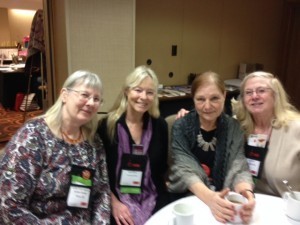
Kathy/Kaitlyn, Kate, Dorothy and Lea
tall milfs cougars that crave black cocksAs most folks reading this blog already know, Kate, Lea, Dorothy, Brenda and I spent last weekend at Malice Domestic in Bethesda, Maryland, along with six hundred or so like-minded folks. I stayed over till Monday before flying home to Maine. By the time you read this on Thursday, my brain may be functional again, but I wouldn’t bet money on it. I may be caught up on laundry . . . or not. What I will be, is glad I went. I always am. I can’t say for certain how many Malice Domestics I’ve attended, but I’m thinking it’s upward of twenty. I started with Malice III and this year was Malice 27. I don’t know when they switched from Roman numerals, either. I should find out.
Anyway, don’t expect too much coherence in this post. I’m just going to ramble a bit about this year’s experience. I was going to take pictures and did, in fact, take a few, but I’m a terrible photographer. The blurry ones are mine. The ones in focus were taken by people with more skill and steadier hands than I have.
It’s always a shock to head south in the spring. Maine still had brown grass, no leaves on the trees, and precious few flowers when I left on the last day of April. The Washington D.C. area, including Bethesda, is incredibly green. Plus all those flowering trees and bushes. And it’s warmer than here. And it’s humid!! It always takes me a day or so just to adjust to being at sea level. Did you know that our nation’s capitol was built on a swamp? Still feels like one when you’re used cold and dry.

projected image above lobby bar
But onward to Malice itself. I flew down on the same plane with Lea, and with Steve Steinbock, who has guest posted here. He does the book reviews for Ellery Queen Mystery Magazine. We shared a cab to the hotel, about a half hour ride through all that greenery. It didn’t take long after arriving to start seeing familiar faces. In fact, my room was right next door to Sherry Harris from the Wicked Cozy blog. We were on the first floor, which is kind of cool. You can take the elevator down, or you can walk through the area used for book signings and down the grand staircase to the lobby. There’s also an excellent view of the lobby bar, since the hotel is designed atrium style (I think that’s the right term)—good for spotting who’s already there.
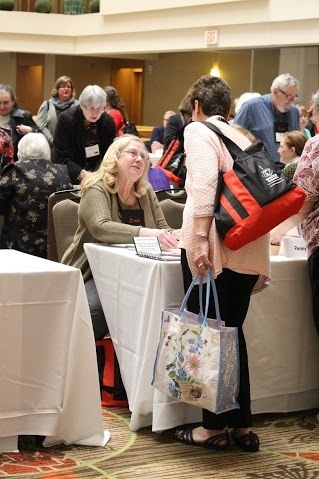
Lea Wait at group signing–photo by Morgan Elwell of Kensington Books
Now I don’t want you to think I’m a barfly. In fact, I don’t usually drink at all (bad reaction with my blood pressure meds), but the hotel lobby bar is THE place to meet both old friends and new ones. I had a very interesting chat with Cheryl Hollon, who is writing a cozy series based around a stained glass shop. The first entry, Pane and Suffering, will be out in September. I connected with old friend Jan Giles, who comes to Malice every year . . . from her home in Bahrain. That’s an 18 hour flight. I finally met and had the chance to talk with Mo Heedles, from New Hampshire, who won character-naming rights in a future Liss MacCrimmon novel at last year’s Malice Domestic charity auction. Mo will be in this fall’s entry, The Scottie Barked at Midnight. And of course I reconnected with long-time conference-going pals—yes, Dina, I mean you—and caught up on cats, books, and all the other things traditional mystery readers have in common.
Historical mysteries seem to be alive and well. Jessie Crockett, another of the Wicked Cozies (we think of them as our “sister blog” because we share Barb Ross) is researching one, which led to a conversation about library and historical society holdings. And speaking of history, the first session I attended was put on by two archaeologists who explained how they discovered the identity of a body found in an iron coffin during an excavation. Thanks to DNA testing, they succeeded in reuniting this young man with his family after nearly two hundred years. Fascinating stuff.
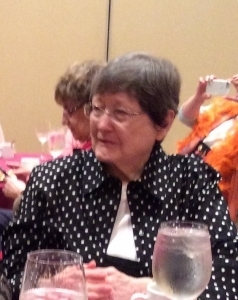
good friend JoAnna Carl
Some of my own favorite authors are old friends as well as Malice regulars—Rhys Bowen, JoAnna Carl, Margaret Maron, and Victoria Thompson (who is next year’s Guest of Honor). If you haven’t read relatively new writer Gigi Pandian, give her Jaya Jones series a try. Then there was what’s becoming a semi-regular tradition, going out to eat on Friday night with Lea Wait, Maddy Hunter, Kathleen Earnst, and Kathleen’s sister Barbara.
 I met with my agent, Christina Hogrebe, with unexpected (but good) results. You never know how those conversations will turn out! We’re planning ahead. Way ahead. For the time after I turn in the tenth book in the Liss MacCrimmon series. That manuscript is currently “resting” so I will have a bit of perspective on it when I go back to it to revise. First though, sometime very soon, I will be receiving edits from my new editor for the Rosamond Jaffrey historical mysteries. I have no idea what to expect there, but my fingers are crossed that not much will need changing. On the other hand, a good editor makes a book better, so I’m always open to suggestions.
I met with my agent, Christina Hogrebe, with unexpected (but good) results. You never know how those conversations will turn out! We’re planning ahead. Way ahead. For the time after I turn in the tenth book in the Liss MacCrimmon series. That manuscript is currently “resting” so I will have a bit of perspective on it when I go back to it to revise. First though, sometime very soon, I will be receiving edits from my new editor for the Rosamond Jaffrey historical mysteries. I have no idea what to expect there, but my fingers are crossed that not much will need changing. On the other hand, a good editor makes a book better, so I’m always open to suggestions.
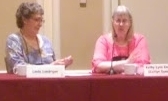 My panel, consisting of the nominees for best short story (me, Barb Goffman, Edith Maxwell, and Art Taylor), was moderated by Linda Landrigan, editor of Alfred Hitchcock Mystery Magazine, and was a continuation of the blog tour we all went on together during the last couple of months. In person, it was even better. I enjoyed spending time chatting with the other nominees and even ended up getting some valuable feedback from Barb Goffman, who is very good at that sort of thing, during a casual conversation on the lobby bar. Oh, did you want to know about the Agatha award? Nope. Didn’t win. It went to Art Taylor. His acceptance speech mentioned our blog tour and the good feelings it engendered among us. Sure, I would have loved to bring home a Malice teapot, but I don’t feel bad about returning to Maine without one.
My panel, consisting of the nominees for best short story (me, Barb Goffman, Edith Maxwell, and Art Taylor), was moderated by Linda Landrigan, editor of Alfred Hitchcock Mystery Magazine, and was a continuation of the blog tour we all went on together during the last couple of months. In person, it was even better. I enjoyed spending time chatting with the other nominees and even ended up getting some valuable feedback from Barb Goffman, who is very good at that sort of thing, during a casual conversation on the lobby bar. Oh, did you want to know about the Agatha award? Nope. Didn’t win. It went to Art Taylor. His acceptance speech mentioned our blog tour and the good feelings it engendered among us. Sure, I would have loved to bring home a Malice teapot, but I don’t feel bad about returning to Maine without one.
I spent some time in the dealer room with old friend Chris Cowan, who makes and sells jewelry. Not as much as I’d have liked to. My arthritic ankles were giving me fits, making it hard to do a lot of walking around. Chris found an adorable Scottie pin to go with The Scottie Barked at Midnight. I’ll save a picture of that for a later post.
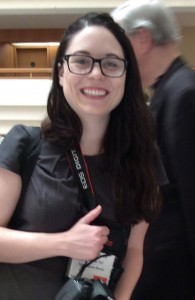
Morgan Elwell, armed with camera
Another new acquaintance was Morgan Elwell, Communications and Marketing Manager for Kensington Books. She brought freebies: little sewing kits with Kensington’s name and a URL printed on them. She tells me she brought 400. They disappeared fast. Someone else was giving away pill cases. For the most part, though, the PR material consisted of postcards, flyers, pens, and buttons.
I did warn you I was going to ramble. Oddly enough, one of the prevalent topics of conversation was other conferences, particularly ones where some of us might meet again in the not-to-distant future. Some of us will be at the Historical Novel Society conference in Denver next month. Others are already registered for Bouchercon in Raleigh, North Carolina in October. Registration is about to open for the next New England Crime Bake in Massachusetts. And it wasn’t too soon to talk about the next Maine Crime Wave, either, even though it doesn’t yet have a set date. I wouldn’t be at all surprised if some of the Malice people make it to Maine next April.
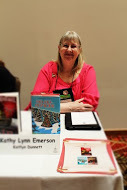 One thing everyone at Malice has in common is a love of mysteries. This year, three of the remaining long-time mystery booksellers were represented in the Dealer Room: Aunt Agatha’s, Mystery Loves Company, and Scene of the Crime. I made a point of buying books from all three of them, even though, to be honest, these days it is easier for me to read on my iPad and enlarge the font. Why? Because if we don’t support independent booksellers when we can and, yes, pay full price for those books, even though it would be cheaper to buy them on Amazon, then even more bookstores will go out of business. Trust me, no one wants that!
One thing everyone at Malice has in common is a love of mysteries. This year, three of the remaining long-time mystery booksellers were represented in the Dealer Room: Aunt Agatha’s, Mystery Loves Company, and Scene of the Crime. I made a point of buying books from all three of them, even though, to be honest, these days it is easier for me to read on my iPad and enlarge the font. Why? Because if we don’t support independent booksellers when we can and, yes, pay full price for those books, even though it would be cheaper to buy them on Amazon, then even more bookstores will go out of business. Trust me, no one wants that!
Now, however, I am faced with a dilemma. Which one of the fifteen hardcover and paperback books I schlepped home from Malice do I read first?
Feel the Mystery Burn
Hello, friends:
Gerry Boyle here. My friend Kate Flora graciously invited me to write something to coincide with the launch of ONCE BURNED, the new and 10th Jack McMorrow novel, to be released by Islandport Press next week. The book is about arson. The need to keep on writing these stories is burning, too.
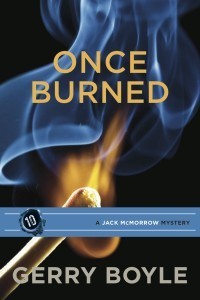 This has been on my mind these last few weeks. I turned in the manuscript for the McMorrow No. 11, STRAW MAN, last month. Since then I’ve had plenty to do—a revision of an Irish crime novel (co-written with my Irish daughter, Emily Westbrooks), my Colby Magazine work, a quick trip to the Southwest, cleaning up the yard after a long Maine winter, getting the boat ready for the season, hanging out with family—but I feel unsettled.
This has been on my mind these last few weeks. I turned in the manuscript for the McMorrow No. 11, STRAW MAN, last month. Since then I’ve had plenty to do—a revision of an Irish crime novel (co-written with my Irish daughter, Emily Westbrooks), my Colby Magazine work, a quick trip to the Southwest, cleaning up the yard after a long Maine winter, getting the boat ready for the season, hanging out with family—but I feel unsettled.
A little jumpy.
Hard to sit still.
I wasn’t sure why until last week when I was doing an interview with Caroline Cornish, for the WCSH television show 207. Caroline asked me how I keep coming up with ideas for McMorrow novels after 20 years. I don’t recall my response. But I know now what I should have said: “How can I help it?”
The truth is that writing a mystery series is like a relationship. It is a relationship, with a character who may be the person—imagined, yes—you spend as much time with as any actual person. You are inside that protagonist’s head. You’re thinking about their life. You’re with them in very dangerous situations, and you’re with them in their quiet moments as well. You invented them, and their significant others, their cast of supporting characters, and if you get lucky, and readers keep reading, you’re with them until death does you part.
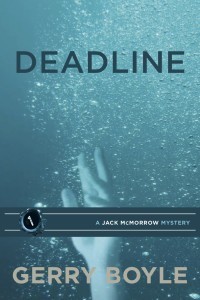 If you get very lucky, you’ll go first.
If you get very lucky, you’ll go first.
It’s a little whacked. I mean, you could be writing literary novels. You could be writing poetry. You could be writing your memoir. Instead, you’ve tied the knot with this one person, and that person is in constant trouble, turmoil, physical danger, and at psychological risk. You need them as much as they need you. Or maybe more.
My main man is McMorrow, the rogue newspaper reporter who for 20 years has been exploring the minefields of Maine. He and I go way back, to when I was a cub reporter and he was the jaded veteran late of the New York Times. I gave him raison d’etre and in return he took me under his wing. He’s one interesting guy, I think. Tough, principled, vigilant in his determination that the truth be revealed and justice served.
His best friend, Clair, is a Marine, a Vietnam veteran, ex-special forces philosopher. His wife, Roxanne, works with troubled kids and keeps her most troubled kid, McMorrow himself, from going over the edge. She’s the second-strongest woman I know.
So here we are, me and McMorrow. Joined at the keyboard, which might as well be the hip.
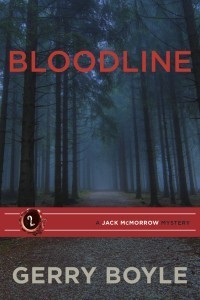 I have no trouble coming up with ideas, no more than McMorrow has trouble picking battles. When I’m not with him, I have this uneasy feeling (see above) that he’s out there without me. And I hate to miss a minute.
I have no trouble coming up with ideas, no more than McMorrow has trouble picking battles. When I’m not with him, I have this uneasy feeling (see above) that he’s out there without me. And I hate to miss a minute.
Of course, I could be writing these books for myself. I’m fortunate that I’m not the only one who finds McMorrow interesting—a real blessing, that.
It’s not something you do lightly. I thought that as I read Brenda Buchanan’s nice post here about joining the ranks of mystery novelists. All those years of work. All those hours with someone you’ll grow very close to over the years. All those near-death experiences you share and learn from. Best of luck to you both.
Brenda made reference to Robert B. Parker, the wonderful writer who taught her in college and was a big help to me when I was starting out. Parker died very suddenly, at his writing desk. It was very unexpected and devastating to his family and friends and many thousands of fans. But he was spared one thing: he didn’t have to part with Spenser, his fictional counterpart for more than 30 years.
That sort of parting is difficult to contemplate. So I’m not. In the words of Ruth Rendell, who died last week, wrote wonderful mystery novels all of her life, “I couldn’t do that.” Writing, Rendell said “is essential to my life.”
So on we go. ONCE BURNED is about arson and revenge. STRAW MAN is about guns and true faith. The next one? We’re mulling. For me and McMorrow, it’s full speed ahead.
May 4, 2015
Loony, Light and Dark

Everyone wore a rock band related t-shirt to the party
John Clark, sitting in the most cluttered writing space in Maine. We’ve lived in this house for 12 years. When we first looked at it, Beth and I were excited because we saw personal space possibilities that had been unavailable in our previous home. I chose the room across the hall from our bedroom that looks out over where the town pool used to be. In fact, the remains complete with stagnant water, were still extant that first summer and we were serenaded every night by enough frogs to make one think they were in Africa.
The room remains essentially unchanged to this day. There’s a newer computer desk that’s already begging to retire, four computers and a ton of peripheral storage drives. It has a neat window seat thingy with storage space under it, but there’s so much clutter on top that I don’t think I’ve looked to see what I’ve stashed there in a couple years. Most of the remaining floor space is covered with piles of books, DVDs and music CDs. Some are waiting to be cataloged, but more are waiting to be read or listened to. There’s a subtle delight in the insanity of anticipation. Last time I checked, I had 80 gigabytes of music, all legally copied from my CDs or purchased online. If I started listening now, I’d be dead before I finished, but I still trade CDs online at swapacd.com, a sister site of paperbackswap.com where I’ve traded several thousand books and audio books. These two have another allied site, swapadvd.com where I trade duplicate DVDs for the library. Lately, I’ve been accumulating horror movies that no other library in Maine has because my patrons are really into that genre. See how easy it is to digress. Anyhow, there must be at least a hundred books in my TBR piles, but that doesn’t stop me from adding more.
You might think with traffic going by constantly, the subtle lure of a book begging to be read, etc. that writing in this mancave of clutter would be difficult. Oddly enough, it’s not, mainly because between the internet and the stuff lying around, I can find the information or the spark I need to move forward. Here’s an example. I had this great scene in my head for the current book where Skye and her new friend, Tina who also is a really good basketball player, but has almost no money, decide to go on a girls day out shopping spree to a number of thrift stores, starting in Ellsworth. It took a bit of convincing for Skye to get Tina to agree to being treated to whatever the heck caught her fancy, but once that happens, they start in Ellsworth and then go up Rt. 1A to Bangor. On the way back coming over the Airline, they’re chased by a couple really evil bikers and what happens is pretty dramatic, requiring cops and an ambulance. I needed to be sure that the place where it happened was across the line into Washington County so the right sheriff’s department would show up. That’s why I have my DeLorme Atlas sitting on top of the box of books next to my desk. The scene came out perfectly after I moved it about five miles east of where I’d planned to have it happen.
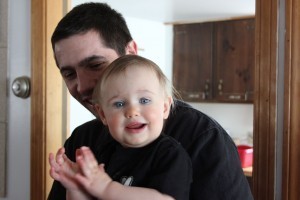
Daddy taught me to applaud a good performance.
On to the light portion of this blog entry. March third was my granddaughter Piper’s first birthday, but Sara and Russ decided they wanted a big celebration, not only because there were a lot of cousins who hadn’t met Piper yet, but also as a celebration of Sara coming back from a pretty severe case of postpartum depression. They rented the community building in North Belgrade and it was a great time. Lots of laughter, games, eats and cake. Since there were younger cousins from both sides of the family, it was great fun to watch them look at each other, grin and start playing like they’d known each other for years. Too bad that wonderful trait seems to evaporate by the time we become adults. One of the things Sara put together for Piper is a time capsule in the form of a chest for her to open on her eighteenth birthday. Anyone at the party who wanted to, was encouraged to write a memory or a wish for her and these were all sealed in envelopes. It will be interesting to see how she reacts when it gets opened.
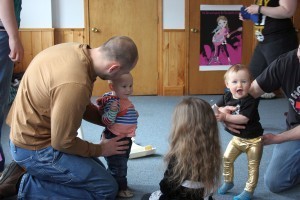
Hey dude, check out my cool threads
She sure is an outgoing and happy kid. We’ve gotten in the habit of saving a bit of our supper so Beth, who takes care of her during the week, can feed it to her the next day. Thus far, we have yet to find a fruit or vegetable that she hasn’t liked. She also loves to blow kisses to anyone who’s leaving. I’m excited for the time when she’s learned to speak and I can help her develop a vocabulary second to none to go with the sense of humor I just know she’ll have.
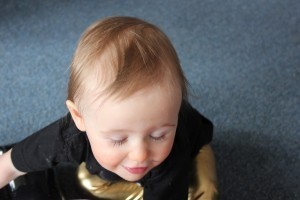
She has her great grandmother’s red hair, will she become a mystery writer too?
The first story I ever had published was called In Your Dreams and appeared in one of the earlier Level Best anthologies. It was actually written as self-therapy because I kept having a recurring dream about killing a woman back when I was still drinking and getting away with it. It was a very dark story. Oddly enough, as soon as I wrote it, I stopped having the dream. I pretty much got away from really dark stories after a while, but this year, when it came time for submissions to both Level Best and the Al Blanchard contest, I got back to my dark roots and sent in two that had fermented in my head very nicely. They’re both fairly short. The shorter of the two took 45 minutes to write and came out much better than the original muddy version in my brain. I’m hoping one of them makes it into the anthology. Over the past ten years, I’ve accumulated a number of short stories I’ve liked, but weren’t selected. Perhaps they’ll end up in an ebook called Somerset County Rejects.
Next time I post, I’ll be introducing you to my replacement at the Hartland Public Library. The search took an unexpected turn, but one that I think is going to work out very nicely and be well received by the library patrons.
May 3, 2015
How Did I Get Here?
You may find yourself living in a shotgun shack And you may find yourself in another part of the world And you may find yourself behind the wheel of a large automobile And you may find yourself in a beautiful house, with a beautiful wife And you may ask yourself-Well…How did I get here? – The Talking Heads, Once in a Lifetime
I am 57 years old, and my debut novel, Quick Pivot, was released last Monday.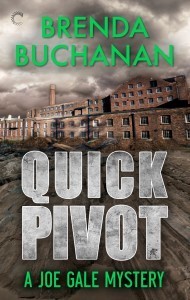
I started imagining this scenario—being a published mystery author—at about the age of ten, when I faced up to the fact that being a cowgirl wasn’t a viable career plan for someone raised in a Massachusetts mill town. I moved a small table and chair into the bedroom I shared with my sister and claimed it as my writing space. I am sure I was insufferable about needing time to create. I no longer have any of the stories I wrote at that little table, which is an excellent thing.
A couple of years later I appropriated my mother’s stand up Underwood and set up shop in the basement playroom, where my hunt-and-peck style was less audible to the rest of the family. After passing through the requisite bad poetry stage, I circled back to crime stories, inspired by the amateur and professional detectives in the mysteries I read constantly.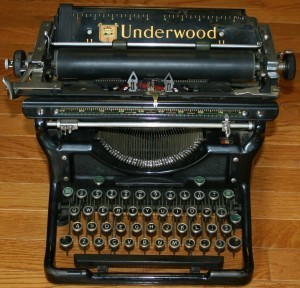
The moment I got to high school I joined the school paper, and eventually became its editor. I went on to study journalism at Northeastern University in Boston, spending my co-op terms at the Boston Globe, but during my academic semesters I managed to sneak in some courses in writing fiction. In one of those truth-is-stranger experiences, my writing prof was Robert B. Parker, who was a few books into his Spenser series and still teaching on the side. I was 20 years old, and my work reflected my limited life experience. But Parker offered feedback and enough encouragement for me to stick into my back pocket the idea that I was capable of writing a publishable novel.
After a number of years working as a newspaper reporter, I went to law school, and have practiced that profession for the past 25 years. For reasons I cannot quite explain, about seven years ago the characters in my Joe Gale Mystery Series began creeping into my consciousness. When their voices grew insistent I realized if I were ever going to write fiction in a serious way, it was then or never.
I took some classes. I read a few books. I began going to Crime Bake every fall and took copious notes during the workshops on character, tension and voice. Some friends and I formed a critique group. I gave myself a two-pages-a-night goal. Two pages a night is 15 pages a week, rounding up. That added up to 60 pages a month, I told myself, which would translate to a novel-length manuscript in about six months.
Of course, it didn’t work out that way. It took years for the first manuscript to be written, many months for me to realize it was far from ready for prime time, maybe a year and a half to write the second book. That one became Quick Pivot, with enormous help from thoughtful beta readers, many kind colleagues who bucked me up when I felt discouraged, and an incredibly supportive spouse.
Now I’m finally moving into the world of published writers. I know the work ahead makes the work I’ve already done seem like zippo. But I’m not mystified about how I got here. It was always my destination. I simply took a circuitous route.
Brenda Buchanan is a former newspaper reporter with a deep reverence for small town journalism. Her Joe Gale Mystery Series features an old-school reporter with modern media savvy who covers the Maine crime beat. Brenda holds a journalism degree from Northeastern University and a law degree from the University of Maine. She writes and practices law in Portland, where she lives with her spouse.
Brenda can be found on the web at www.brendabuchananwrites.com and on Twitter at @buchananbrenda
Quick Pivot is available in digital format wherever fine ebooks are sold.
Here’s a plot summary: In 1968, a cunning thief skimmed a half a million dollars from the textile mill that was the beating heart of Riverside, Maine. Sharp-eyed accountant George Desmond discovered the discrepancy, but was killed before he could report it. After stashing the body, the thief-turned-killer manipulated evidence to make it appear Desmond skipped town with the stolen money, ruining his good name forever.
In 2014, veteran journalist Joe Gale is covering a story for the Portland Daily Chronicle when a skeleton falls at his feet: Desmond’s bones have been found a basement crawl space at the long-shuttered mill. For Joe, digging into the past means retracing the steps his mentor Paulie Finnegan had taken years ago, when the case was still open. But the same people who bird-dogged Paulie four decades ago are watching Joe now. As he closes in on the truth, his every move is tracked, and the murderer proves more than willing to kill again.
May 1, 2015
Weekend Update and News from Malice Domestic
Many of us are in Bethesda, Maryland this weekend for the Malice Domestic conference, a mystery conference that celebrates the cozy mystery. We hope to provide updates and photos of your favorite writers. In the meantime, here’s the blog line-up for this coming week:
Monday, Brenda Buchanan, Tuesday, John Clark, Wednesday, Gerry Boyle, Thursday, Kathy Lynn Emerson/Kaitlyn Dunnett, Friday, Vaughn Hardacker
And while poor Barbara Ross is laid up with a bad knee and unable to celebrate this week’s debut of Musseled Out with us here at the conference, Dorothy Cannell has been busy being made an honorary member of the Guppies (the sisters in crime on-line group of the great unpublished) and giving out the first annual Dorothy Cannell scholarship donated by her wonderful agent, Meg Ruley, to allow someone to attend this great fan conference for free. Photos below are Dorothy getting invested with her guppy feather boa (de rigueur for Guppies) and giving out the scholarship. And Brenda Buchanan at her first ever book signing:
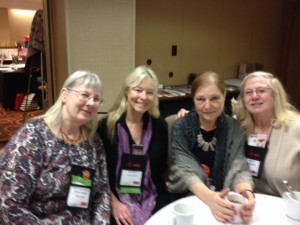
Kathy, Kate, Dorothy and Lea at Malice Domestic in Bethesda
tall milfs cougars that crave black cocks
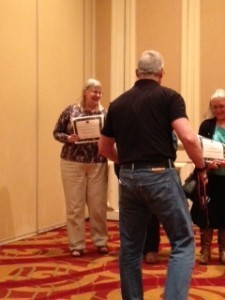
Photographer looks like he is attacking Kaitlyn Dunnett after she gets her nominee certificate
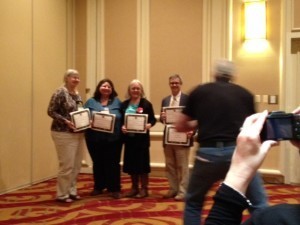
Kathy Lynn Emerson, Barb Goffman, Edith Maxwell and Art Taylor, Agatha short story nominees
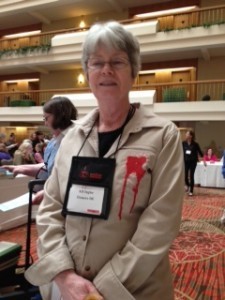
Her daughter gave her this shirt! Can you see that this is a true mystery lover?
Brenda and Gerry will be talking more about their new books, launching this week, but here are their gorgeous covers. You DON’T WANT TO MISS THESE READS!!
April 30, 2015
Bulletin from Writer’s Camp
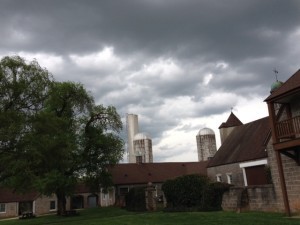
Kate Flora here, writing from a cinderblock studio on a hilltop in rural Virginia. For two glorious weeks, I am in the writing chair at least ten hours a day, my only job to write, and write, and write. As you read this, I’ll be in my car, driving up to Bethesda, Maryland and the Malice Domestic conference. But for a few more glorious days, I’ll be in my writing studio at the Virginia Center for the Creative Arts, surrounded by composers and artists and other writers, breathing the rarified air of creativity.
Although I believe my job here is to be open to whatever stories want to come, my plan was to buckle down and finish a first draft of my next Joe Burgess book, And Led Them Thus Astray. I arrived with about 37,000 words. I will leave with a finished book at 94,000 words. If I was lucky enough to get the book done, I wanted to try and write a short story about my character, Gracie Christian, to submit to the Level Best Books crime story anthology. That story is now done and printed out, ready for a trip to the post office.
When we gather at breakfast and dinner here, fellows frequently talk about what is so special about 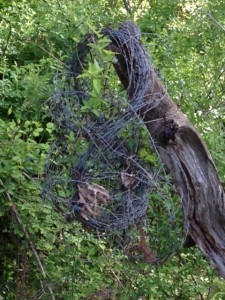 this experience–the uninterrupted working time. Most of us who are writers have a writing practice, but our days are punctuated by the other routines of life–jobs, meal prep, bill paying, gardening, teaching, editing, speaking, interacting with family and others. Here it can be all about the work. All day, and even all night if the story is calling. I call it glorious obsession. My first time here, I had ten days and I wrote 167 pages of a story I’d never had time for. Two nights ago, stuck on a scene that just wouldn’t write, I suddenly had a breakthough, a character started talking, and I sat, grinning with delight, for two hours while the story unfolded.
this experience–the uninterrupted working time. Most of us who are writers have a writing practice, but our days are punctuated by the other routines of life–jobs, meal prep, bill paying, gardening, teaching, editing, speaking, interacting with family and others. Here it can be all about the work. All day, and even all night if the story is calling. I call it glorious obsession. My first time here, I had ten days and I wrote 167 pages of a story I’d never had time for. Two nights ago, stuck on a scene that just wouldn’t write, I suddenly had a breakthough, a character started talking, and I sat, grinning with delight, for two hours while the story unfolded.
Going to open studies and seeing what the artists are doing, listening to composers share their new works, and going to author’s readings–all are optional, but it’s an option most residents choose, because being exposed to new ways of seeing, and new ideas about process, is something that can change our own thinking, open our minds to new ideas, and sometimes just be inspiring because someone has taken something very ordinary and made it extraordinary. The experience of being here, we all agree, is such a gift. If only we could bottle it and bring it home.
Yet it will come home, in the fabulous one-liners over breakfast, in the way that we see and hear color and music intertwined. In the way a lifetime of reading is translated to very personal library cards. In the way other fellows remind that process, as well as product, is important.
So I’m only taking a small break here to write this, because the work is calling me back. But I wanted to share two new books that I have had a part in, that will be appearing in the months to come.
First is a book called Dead in Good Company, a collection of essays about Mount Auburn Cemetery in Cambridge, Massachusetts that is the brain-child of John Garp Harrison. I am honored that title of the essay I submitted has been chosen as the title for the collection. Here’s a link to a radio program discussing the book.
Second, and on a far lighter note, is a group novel produced by my other blog group, Thalia Press Authors’ Co-op, (Views from the Muse) by our fictitious author, Thalia Filbert. Here’s that cover, and some draft cover copy. For those curious about our cover fonts, we’ve used bacon, black pasta, and hot peppers. We’re aiming for a September debut.
 Like your barbeque and sex spicy? Your murders saucy and well done? Lobster and bad guys boiled red hot and served with lemon and butter? Welcome to the fascinating and competitive world of celebrity chefs and food culture, in a wry, witty crime story where cutting edge takes on a new meaning when the chefs start dying.
Like your barbeque and sex spicy? Your murders saucy and well done? Lobster and bad guys boiled red hot and served with lemon and butter? Welcome to the fascinating and competitive world of celebrity chefs and food culture, in a wry, witty crime story where cutting edge takes on a new meaning when the chefs start dying.
Aspiring chef Anna Wendt has a multitude of talents–facility in the kitchen, in the bedroom, and, she discovers, for disposing of bothersome chefs. An adept sous chef and gifted food stylist, Anna would have worked her way up to become a head chef somewhere trendy, and her talents would have blossomed. But wronged by those who steal her recipes, ridicule her weight, and denigrate her talents, Anna turns her imagination and culinary savvy to satisfying her hunger for revenge.
The first time she exacts fatal recompense, she’s surprised at how easy is to stage a fabulous tableau, and at the peculiar excitement that killing brings. Hooked on how tasty revenge can be, she begins bumping off famous chefs in spectacular, cooking-related ways.
Anna is on a roll until chubby, nerdy food blogger Jason Bainbridge, looking for his big break, begins to see a pattern in the killings. Bainbridge forms an uneasy alliance with cool, bitchy, hard-charging FBI agent Kimberly Douglas as the search goes full throttle for the one who is killing celebrity chefs across America.
As the hunt for Anna closes in, our anti-heroine doubles down in a page-turner food fight that will leave you gasping, laughing, and applauding as it comes to a delicious climax.
Debut author Thalia Filbert’s darkly comic sendup of serial killers, food mysteries, chick lit, and the iconic Eat Pray Love, finds the sweet spot between appetizers and dessert in this rollicking trip from sea to shining sea. From color-themed dinners to Maine lobster pots, from barbeque to huckleberries, this mystery is stuffed to the gills with knives, mayhem, and laughs. Grab a fork and dig in.
ABOUT THE AUTHOR
Thalia Filbert’s lust for food, travel, and a good story is legendary. Now she’s combined it all in one delicious package. Her debut novel, Beat Slay Love, highlights her love of the underdog, American regional food, and that special dish best served cold: revenge. She attended culinary school at a posh Napa Valley academy and did the obligatory stint in European bistro kitchens. Although from a backwoods Midwestern town where she learned to make squirrel, woodchuck, and possum au vin, she escaped in the nick of time, leaving a hungry man at the altar. She’s never looked back. She’d like to thank her muses, veteran crime fiction writers Taffy Cannon, Kate Flora, Lise McClendon, Katy Munger and Gary Phillips, for everything.
 Read this far? Well, here’s this week’s special offer: someone who comments on this post will get a free audible download of my novella, Girls’ Night Out.
Read this far? Well, here’s this week’s special offer: someone who comments on this post will get a free audible download of my novella, Girls’ Night Out.
April 29, 2015
Musseled Out Released!
Hi. Barb here. I’m celebrating the release of Musseled Out by giving away a copy of the book to one lucky commenter.
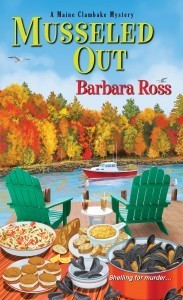 I’m thrilled to announce that Musseled Out, the third book in the Maine Clambake Mystery series, was released today in print and ebook form by Kensington Publishing.
I’m thrilled to announce that Musseled Out, the third book in the Maine Clambake Mystery series, was released today in print and ebook form by Kensington Publishing.
And, Musseled Out will soon be released in audiobook format by Audible.
Here’s the blurb:
The busy summer tourist season is winding down in Busman’s Harbor, Maine, but Julia Snowden senses trouble simmering for the Snowden Family Clambake Company. Shifty David Thwing, the “Mussel King,” is sniffing around town for a new location. When Thwing is found sleeping with the fishes beneath a local lobsterman’s boat, the police quickly finger Julia’s brother-in-law Sonny as the one who cooked up the crime. Julia believes he’s innocent, but proving it won’t be easy. There’s a lot more than murder on the menu, and Julia needs to act fast. . .
You can purchase Musseled Out at your local independent bookstore, at a bricks-and-mortar Barnes & Noble, and at B&N online, Amazon and many other e-retailers.
Reviews
The reviews have been great, which is very gratifying, considering I thought this book was trying to kill me. I handed it in a month late (something I had never done before) and there were times when I thought it would never come together. But then it did. (I think I’ve just described the writer’s life in a nutshell.)
☆☆☆☆½ The latest trip to Busman’s Harbor is a lobster pot full of secrets and deceit. This cozy series continues to stand out with its exceptional plotting, intriguing storylines and authentic detailing of the lobstering life.
RT Book Reviews, May 2015
Musseled Out, the third of Barbara Ross’ stellar Maine Clambake Mysteries, is a craftily plotted, brilliantly paced tale that gives the lie to the notion that all small-town crime is cozy. Addiction, greed, ambition, murder – Musseled Out has them all, plus a bonus lesson in lobstering and a turf war, to boot.
Crimespree Magazine, April 2015
Boasting an eclectic cast of characters, good conversation and a small town feel, this is my favorite book in the series.
Dru’s Book Musings, April 2015
Each book is getting better — and the first one was pretty darned good, so by now, the Maine Clambake series is one of the best amateur sleuth…mystery series coming out of New England.
Kingdom Books, April 2015
Of course, here at Maine Crime Writers, I’ve kept you up to date on the doings with this book right along, so it’s gratifying to see it come full cycle.
Here’s a post I did on the lobstering research.
Gone Lobstering, May 2014
And another with one of the delicious recipes in Mussled Out developed by my husband and partner in crime, Bill Carito.
Slow-Cooker Curried Fish & Butternut Squash Stew, October 2014
Here’s one from when I broke out of book jail.
When I Finish My Book I’m Going To…, July 2014
I have so many people to thank for helping me with this book, but here I’d like to thank my fellow Maine Crime Writers who have made me feel so welcome in the writing community in Maine.
If you’d like to be one of the first on your block to have your very own copy, leave a comment below and one lucky winner will receive the prize.
April 28, 2015
Instant Ancestor
Lea Wait, here. I don’t remember a time I didn’t know about the quest for “instant ancestors.”
Portraits of my real ancestors, on my mother’s side, hung In the home where I grew up: four large portraits of two couples from Edinburgh, painted in the middle of the nineteenth century. I remember my grandmother pointing at one of the women and telling me I’d inherited her blue eyes. Perhaps unlikely, but a connection to the past.
Those people on the walls were part of my history. I didn’t think much about them, to be honest.
But as I grew up I realized that for some people, portraits or, to a lesser extent, photographs, of ancestors were particularly important, perhaps to establish the importance of their forebears. (Poor families didn’t have their portraits painted.) In fact, for a percentage of those people, portraits of ancestors are so important, that, if they don’t inherit any, they buy them. 
Since I grew up in the antique business, I remember dealers who specialized in paintings joking about their customers looking for to fill their living room or dining room walls with portraits. “Instant ancestors,” the dealers called them — out of hearing of the customers, of course.
There have always been families who were either tired of their family portraits, or had no space for them, or felt they didn’t match a modern décor. So portraits do come on the market.
Most people were looking for attractive white people, fashionably dressed, and painted by, if not a “name” painter, than at least a competent one. (Folk art portraits often are more valuable as art, but not always saleable as relatives.)
From the point of view of the buyers, it didn’t matter who the people were or the artist was. And unsigned paintings, without provenance (the history of the painting and perhaps the subject) are less valuable than those of specific people. So it all worked out.
I never thought much about it.
And then, after my mother died, the portraits that were in her house went to one of my sisters. I had agreed to that. And with a husband who is an artist, and an antique print business, we had plenty of choices of what to hang on our walls.
Then, about ten years ago my husband and I were doing the fall Rhinebeck Antiques Show (the show I fictionalize in Shadows at the Fair). I’d done the show for almost thirty years. I loved the show, and the dealers. But the buyers were changing, and the dealers were retiring. Instead of being one of our best shows of the year, we were barely making expenses. As we sat, hoping for sales, we decided we probably not do the show again.
It was a sad moment.
The dealer across the aisle from us, an older woman from Connecticut, was also saying it might be her last Rhinebeck. She had cancer. As the weekend went by, we talked. And from where we sat in our booth we looked directly at a portrait she’d hung in her booth.
The portrait was of a young woman, not perfectly painted, but distinctive. All the dealer knew was that she’d lived in Connecticut, probably in the first half of the 19th century.
Saturday night I checked the price tag. It was fair, but oo high for us, who were worried about paying our booth rent. I pointed the portrait out to my husband and, to my surprise, he told me he’d been fascinated by it all weekend, too.
Sunday afternoon before packing out I admired it once more. And the dealer said, “I’ll give you a good price. I need to move some inventory. And you don’t have to pay me everything now.”
A quick consultation with my husband and the mysterious woman ended up in our van, headed for Maine. It was an impulse buy. We paid for her over the next few months.
And now she hangs over our dining room fireplace. People often ask, “Is she a relative?”
And we answer, “No. She’s a friend.”
Someday I may put her in a book. But, in addition to the mystery of who she is, she brings with her memories of all my years at the Rhinebeck Antique Show. And, at least for our lifetimes, she’s found a new family.
On the Trail of a Story
Vicki Doudera here, in the throes of finishing a short crime story.
Well – kind of – because right now I’m writing this blog, and yesterday I had to put in several hours at my “other” job as a real estate agent… and yet, I am finishing a short story.
Many people ask me how I hold down a full-time job, as well as a new part-time one as a co-host of a talk show on a new television network here in the midcoast. (www.vstv.me if you are interested – and my show is called “Soup du Jour”) and yet still manage to get writing done.
The answer is: it isn’t easy.
I do it by making a conscious effort to get myself in my office as often as I can to physically write, and then, when I am not in my office, I make a conscious effort to work on my story in my head. It’s not writing, but it’s close. It’s figuring out the details. Playing around with the big picture. Giving my brain the freedom to ramble with an idea.
I do this while I am driving to appointments, or walking to work. I ask myself how I’ll solve a particular plot point, and then, while my feet pound the pavement, I let my mind roam. Some of the ideas are gold – some are just steps along the way. But all of them help as I navigate the elusive trail we call fiction.
Would I love to have the whole day to do nearly nothing but write? Sometimes I long for that, and then I remember that I lived that lifestyle thirteen years ago, before I went into real estate. And although I had a good chunk of time everyday to work on the magazine articles I was writing at the time, I can’t say that I used the time very efficiently. In fact, I would say looking back that I squandered much of it!
Not that it matters, because it’s in the past, and my present now includes commitments in addition to my writing assignments: jobs, volunteer posts, hobbies. At times I do feel like a juggler. Sometimes I’m a very agile one, and sometimes it seems I’m dropping lots of balls. Back in March I let a few fall to the floor, including posting for this blog. Please forgive me, gentle readers.
If there is any upside to my fragmentation, it’s this: when I do sit down at my desk to write, I breathe a happy sigh and feel a sense of bliss. Finishing a short story is not my chore, but my privilege.
And so I will chip away and get it done. Meanwhile…. sending creative thoughts your way as we approach the month of May!
Lea Wait's Blog
- Lea Wait's profile
- 509 followers


